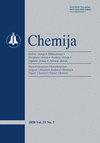Emission of additives and degradation products from commercial polypropylene, polyethylene and their composite packages
IF 0.4
4区 化学
Q4 CHEMISTRY, MULTIDISCIPLINARY
引用次数: 0
Abstract
Migration is a known phenomenon defined as the partitioning of certain chemical compounds from plastic food packaging into food and has been intensely investigated in recent years. Due to outstanding chemical and physical properties plastics are used in many fields. Polypropylene and polyethylene are extensively used polymers because of their chemical resistance, high tensile strength and low density. To improve the properties of the plastics, additives such as plasticizers, stabilizers, antioxidants, lubricants, pigments and others are required to be added. However, they can migrate from the plastics into the food and contaminate it during production or storage. Therefore, the aim of this study was to investigate commercial polypropylene and polyethylene packages to determine what most often used additives and degradation products of the food packages can migrate to food. After the initial identification of plastics by Fourier-transform infrared spectrometry, the determination of cadmium, chromium, lead and mercury was carried out by atomic absorption spectrophotometry. To evaluate possible volatile and semi-volatile organic compounds thermal desorption gas chromatography coupled with mass spectrometry was used. The results revealing the presence of different potential organic compounds and metals emitted during the degradation process of different types of food contact materials are discussed.商用聚丙烯、聚乙烯及其复合包装中添加剂和降解产物的排放
迁移是一种已知的现象,被定义为某些化学化合物从塑料食品包装进入食品,近年来已被广泛研究。由于优异的化学和物理性能,塑料被应用于许多领域。聚丙烯和聚乙烯是广泛使用的聚合物,因为它们的耐化学性,高抗拉强度和低密度。为了改善塑料的性能,需要添加增塑剂、稳定剂、抗氧化剂、润滑剂、颜料等添加剂。然而,它们可以从塑料中迁移到食品中,并在生产或储存过程中污染食品。因此,本研究的目的是调查商用聚丙烯和聚乙烯包装,以确定食品包装中最常用的添加剂和降解产物可以迁移到食品中。在用傅里叶变换红外光谱法对塑料进行初步鉴定后,采用原子吸收分光光度法对镉、铬、铅和汞进行了测定。采用热解吸气相色谱-质谱联用技术评价可能存在的挥发性和半挥发性有机化合物。讨论了不同类型的食品接触材料在降解过程中释放出的不同潜在有机化合物和金属的结果。
本文章由计算机程序翻译,如有差异,请以英文原文为准。
求助全文
约1分钟内获得全文
求助全文
来源期刊

Chemija
化学-化学综合
CiteScore
1.30
自引率
16.70%
发文量
14
审稿时长
>12 weeks
期刊介绍:
Chemija publishes original research articles and reviews from all branches of modern chemistry, including physical, inorganic, analytical, organic, polymer chemistry, electrochemistry, and multidisciplinary approaches.
 求助内容:
求助内容: 应助结果提醒方式:
应助结果提醒方式:


